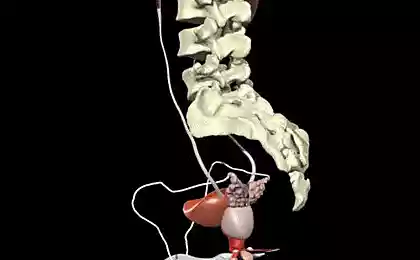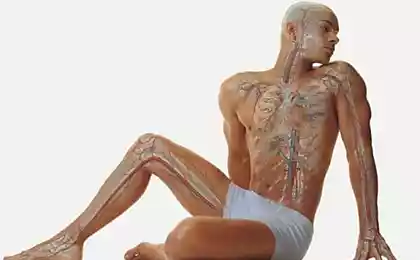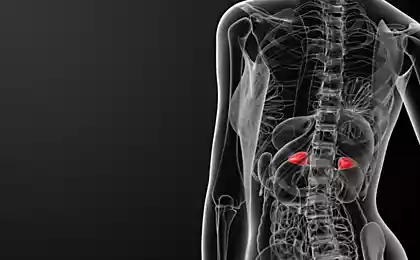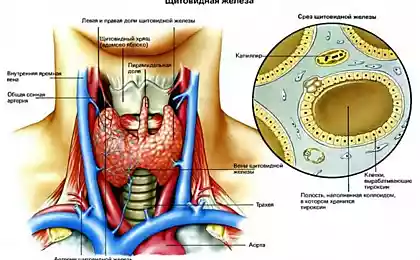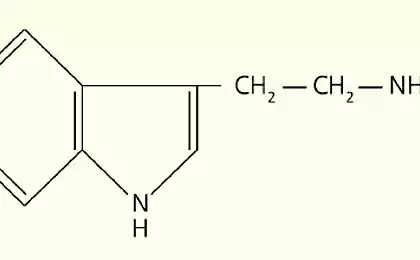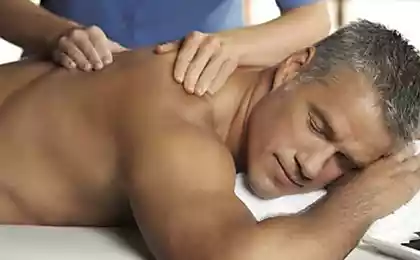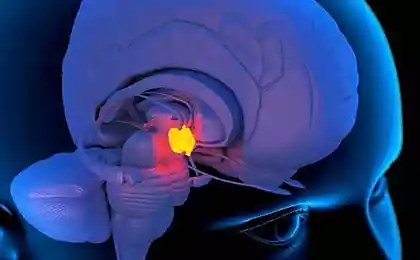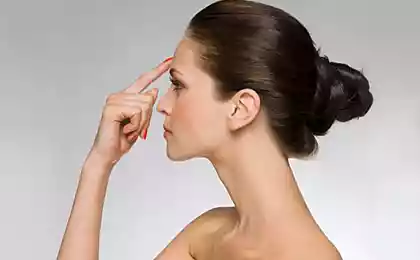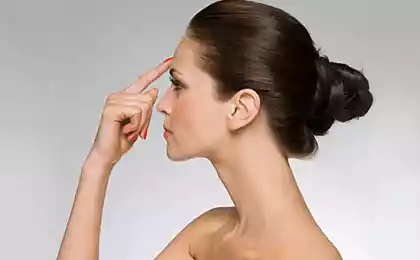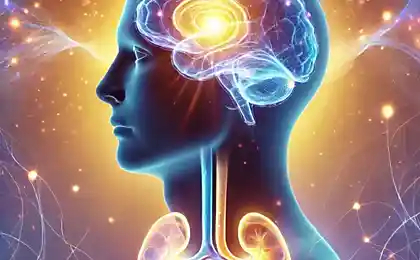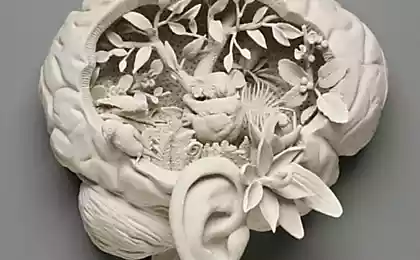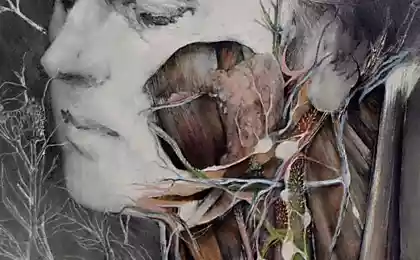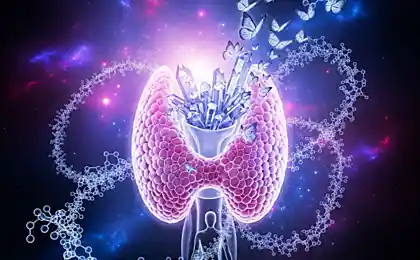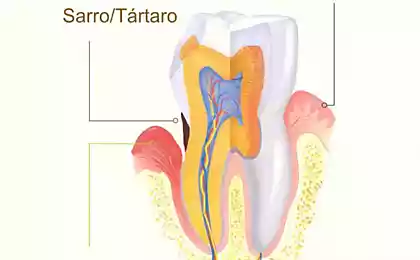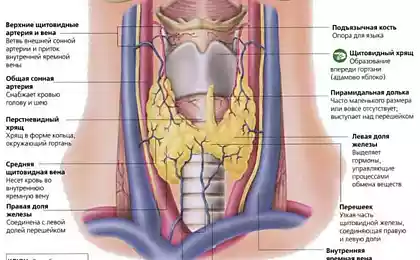1037
The tapping of the thymus and 7 anti-aging exercises for glands
All collected exercises are based on the fact that the most simple and direct way to positively affect the gland technique — tapping and patting. Several exceptions are written below. Health glands is very important, nevertheless, he paid little attention.
The secretion of glands affects every aspect of human physiology in all stages of life, from birth to death. If we also take into account that the secretions of our glands are the substance of Yin, we can say that they affect us from the moment of conception, and even earlier.
Scope of impact includes the growth, development, the process of cell renewal and regeneration (in other words, how quickly and how well we age), sexuality and reproduction, immune support, metabolism, energobrazovania, utilization of nutrients, emotional balance, mental perception, everything is regulated with hormones, and much that at first glance does not depend on hormones. Therefore, maintaining the health of the glands is very important.
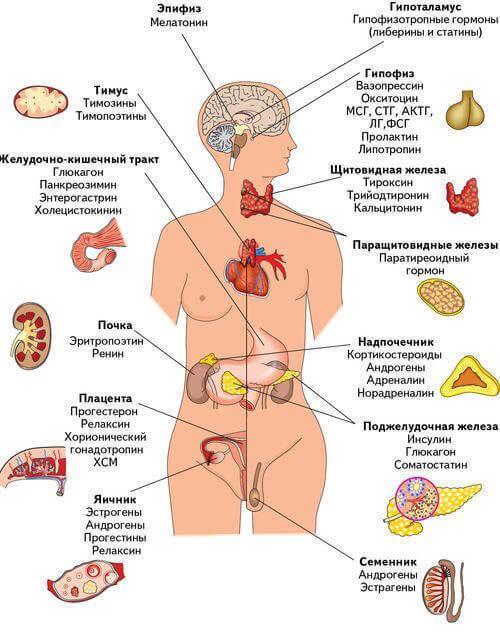
1. The tapping of the epiphysis
The pineal gland is a gland approximately the size of a pea. It is located near the center of the brain between the two hemispheres. It converts nerve signals from the sympathetic nervous system, hormonal, establishing a link between the endocrine and nervous systems. In addition, it produces melatonin, which regulates rhythms of sleep/wakefulness and affects sexual development.
How to perform the exercise
Index and/or middle finger separately, simultaneously or alternately, start rattling the area between the eyebrows at the point, better known as the "third eye".
Although the pineal gland is located in the center of the brain, there is an energy path that connects it with the "external third eye". At this point you can see the notch in the bone, but it may not be. The tapping should be soft and measured, it should cause a pleasant sensation, like a slight tickle.
Prostukivanie 1 or 2 minutes. The number of repeats is not limited. Remember that you need to achieve incremental improvement over time. To achieve this once by long tapping will not work — moreover, it will give the opposite result. You follow energy practices or not, this is an area where easily formed Qi stagnation. Basically, this is manifested headache localized in this region. Mental strain, anxiety, eye strain, and energy practices aimed at lifting energy up the body, but not to the end of providing a reverse circulation (which may be the result of an error or inexperience practitioners), are just a few of the reasons Qi can be stuck there.
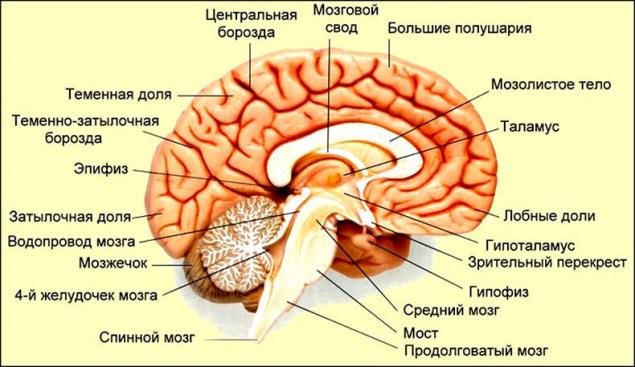
2.Tapping on the pituitary and hypothalamus
The pituitary is located at the base of the brain between the optic nerves, in front of the spinal cord. This small endocrine organ is often called the main gland because it controls other endocrine glands by increasing or decreasing the level of hormones that they produce.
One of the most famous hormones, human growth hormone (HGH) affects cell growth and renewal, regulates other glands and, as many believe, is our internal "fountain of youth". High level of HGH in the blood can slow down and even reverse many signs of aging. In addition, the pituitary gland affects the muscles and kidneys, and even accumulate some of the hormones produced by the hypothalamus.
Located deep in the brain near the center of the cranial cavity, the hypothalamus lies under the thalamus (switching center for sensory and motor pathways in the brain). The latter has a structural and functional connection with the hypothalamus, which is located underneath and is attached with thin bundles of nerve fibers and blood vessels.
This is a control center for many autonomic functions of the peripheral nervous system. Thanks to the relations between the structures of the endocrine and nervous systems hypothalamus plays an important role in maintaining homeostasis, regulating body temperature, blood pressure and heart rate.
It affects the function of the ovaries and testes, mood and behavior, sleep cycles, energy level and overall metabolism. It is sometimes called the "brain" of the brain: almost all the functions of the hypothalamus are to control the brain and its connection with the body, because he is their liaison. Because the pituitary and hypothalamus are anatomically close and their work is interrelated, this exercise is drawn simultaneously to the pituitary gland, and hypothalamus.
How to perform
The easiest way to perform this tapping — approach "shotgun", that is, the promise of relatively strong waves in your head. There are more accurate, specialized methods, but this exercise is very effective and it can perform each.
Gently clench a loose fist and start rattling the back of the head at the base of the skull, beneath the bone and near the side surface of the cervical vertebrae. You can use or extreme knuckle four fingers (Fig. 9.1) or, for a more directional influence, the base of each knuckle side of the little finger (Fig. 9.2).
You can keep your head straight or tilt slightly forward, so if you would prefer to reach the base of the skull. Quickly alternate hands while tapping and direct impact force of the right hand to the left eye and force the left hand to the right eye. Thus, the wave will pass through the pituitary gland and the hypothalamus.
In addition, you can feel like a wave diffuse spreads all over or almost all over the head. This is normal and provides some secondary benefits. As an additional benefit it will soften and relax tense neck muscles that most people are at the base of the skull and on the back of the neck.
Prostukivanie 1-2 minutes. The number of repeats is not limited. Remember that you need to achieve incremental improvement over time. To achieve this once by long tapping will not work, moreover, it will give the opposite result.
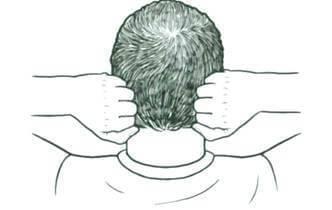
Fig. 9.1. Tapping on the pituitary and hypothalamus
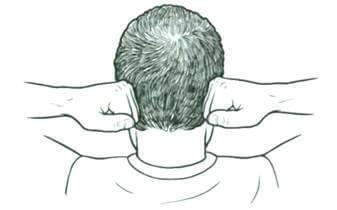
Fig. 9.2. Tapping on the pituitary and hypothalamus
3. Massage of the thyroid gland
The thyroid gland is shaped like a butterfly and located at the base of the front of the neck, under the Adam's Apple along the windpipe. It produces several thyroid hormones. Thyroid hormones affect the whole body, influencing metabolism, growth and development, body temperature. They are necessary for brain development in infancy and childhood, and in adults, they contribute to the functioning of the nervous, cardiovascular and digestive systems.
In addition, this massage is very beneficial for the parathyroid glands, four organs the size of a pea, which are located behind the thyroid gland. They increase the level of calcium in the blood, helping to maintain the integrity of bones and an adequate supply of calcium, which is necessary for the muscle and transfer of intercellular signals.
From the energy point of view, along the front of the neck is the many acupuncture points, through which the meridians of the Stomach and colon. The stomach and its paired Yin organ, the Spleen, affect muscle function of the digestive system; paired organs of the colon are Easy.
Lungs and spleen are involved in metabolism, which affects the production of energy. This coincides with similar functions of the thyroid gland. The base of the throat is also the location of the fifth chakra, which is associated with communication, expression and creativity in the field of communication and expression in it. Honest communication and self-expression in our culture it is often discouraged and surprised, both at work and at home, so the throat is another area where it is often Qi stagnation.
Since the front surface of the neck is more sensitive and not well protected by thick muscles or bones, this exercise is massage, which is performed in three stages. For this exercise, determine the right hands — left hands are not required, you can change hands as you see fit.
How to perform
Place the thumb and forefinger of the left hand at the base of the throat, directly on the clavicles, on bone outgrowths that feel to it. Holding the base of the neck and collarbone, gently push on the latter. Right hand position directly over the left, right thumb over the index finger of the left hand and the index finger of the left hand over the left thumb.
Gently but firmly grasp the sides of the throat and gently slide your right hand up, stretching the throat, while the fingers will not touch the outer edge of the lower jaw (Fig. 9.3). At this point you will feel the sides of the base of the tongue. Gently push up for a few seconds. Repeat this stretch and lift the throat 2 times.
After the third repetition, hold the right hand under the lower jaw, move your left hand to move to the next part of this exercise. So it was easier to hold his throat, add middle and ring fingers. Starting directly under the jaw, slip the throat from side to side to feel how several times you move it back and forth.
There should be no pain, you should not have the feeling that you're choking. Then slightly push the arm down and repeat. Depending on the size of your hands and neck length, you can divide the throat into three, four or five plots, at a time when you move from side to side is one of them. You can feel or hear the crunch when you released the bone. You can feel in the throat a slight tickle that causes the cough.
Both of these reactions are normal. One approach is usually sufficient, but if you want to repeat 2 or 3 times, that's okay too.

Fig. 9.3. Massage of the thyroid gland
The last part of this exercise — direct acupressure. Most of these points are not standard acupuncture, as the needles are directed into the areas of the meridians, which are located in the muscles, not the throat. Here you will use your thumb and index finger as tweezers, directing the force to the sides of the throat and to the extent possible, ago.
During the previous two exercises, you could feel the small grooves on the sides of the throat. You need to press so hard that the fabric physically shifted under your fingers. When you succeed, start making small circular movements with your fingers 10 times in one direction and 10 in the opposite direction. Then slide your fingers down to the next section between the grooves, and repeat. Continue down the neck until you reach the base of the throat.
Note: as in men, in women touching the thyroid cartilage, where men is an outstanding Adam's Apple, feeling during palpation will be very similar to the probing of the bone. In fact, over the thyroid cartilage is a bone called the hyoid, it is fragile, so be careful at any bone site.
Sometimes a weak tilt of the head reveals your neck so that you can feel the depressions between the grooves and there, but you may need to completely skip this area. Not right to put pressure on the bone structure that you can find.
4. The tapping of the thymus
The thymus is a gland composed of lymphatic tissue, which is located in the upper part of the chest, behind the sternum (breast bone), midway between the apex of the heart and the jugular notch of the sternum at the base of the throat. It is most active in childhood and grows up to puberty, after which it begins to atrophy.
In recent years, it became known that the thymus plays an important role in adulthood. It is part of the immune system by converting lymphocytes, white blood cells produced by the bone marrow, T cells developing in the thymus.
These cells migrate to various lymph nodes, where they play an important role in combating infection and diseases. In addition, the thymus produces hormones that regulate the maturation of T-cells. The tapping stimulates the thymus gland, helping to maintain its functional activity in adulthood.
How to perform
Gently squeeze one fist any hand and start to rattle the top edge of the chest over the sternum, below the recess under the throat and above the heart. Change the rhythm, speed and force of the blows, to feelings of discomfort. The body is able to adapt to any repetitive stimulus and, ultimately, to ignore it. Change the speed, rhythm and force of the blows make this impossible. Do this exercise for 1 -2 minutes each day.
5. The tapping of the kidneys/adrenal
The adrenal gland is a paired gland, triangular in shape measuring 2.5-5 cm, behind both kidneys. They produce over 36 of the hormones which are delivered directly into the blood. The function of the outer shell is regulated by the pituitary hormone, called adrenocorticotropic hormone, and it produces steroid hormones such as cortisone and testosterone, which play an important role in the storage and use of energy affect sexual function and many aspects of the chemical composition of blood.
The smaller, inner shell is part of the sympathetic nervous system and responds to physical and emotional stress. Reacting to fear, anger or emergency, it produces epinephrine and norepinephrine (adrenaline and noradrenaline), which is sometimes called the hormone of "fight or flight".
Kidney is bean — shaped organs the size of a fist, located in the lumbar region on both sides of the spine. They filter the blood from toxic substances and excrete them in the urine. In addition, they derive from normal blood substances that are in it in high concentrations (so-called maintenance of homeostasis). The buds themselves are endocrine glands that produce the hormones erythropoietin, which is involved in the formation of red blood cells, and cortisol — the active form of vitamin D.
The main causes of kidney damage are diabetes and hypertension — two diseases most common in our days. This exercise can't fix damage already done but can prevent their occurrence and to support the overall health of the kidneys and adrenal glands.
How to perform
This exercise can be done standing but it is sitting on the floor, in a chair or on a chair much easier. Squeeze both hands into weak fists and either part with the thumb and index finger (Fig. 9.4), or the basis of the kulaks (Fig. 9.5) prostuchite lower back from the lower ribs to the upper part of the pelvis.
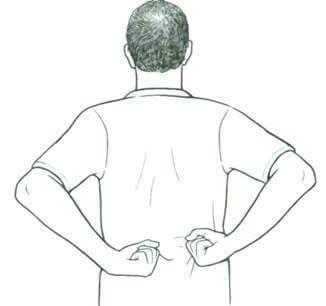
Fig. 9.4. The tapping of the kidneys/adrenal
Many people suffer from tension in the lower back, discomfort, or pain, and this tapping helps to remove them. A hundred lashes for each kidney will take about a minute, and it at least daily for this exercise. If you want to rattle for a few minutes longer. The kidneys are sensitive organs, and therefore, changing the rhythm and speed of tapping, make sure that the blows were not too strong.
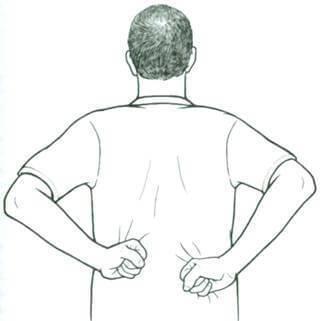
Fig. 9.5. The tapping of the kidneys/adrenal
6. Massage kidney
"The tapping of the kidneys/adrenal glands", as described above, disperse stagnant Qi, and, for many reasons, it needs to be done to "Massage of the kidney". Massage kidney has a soothing, nourishing and warming effect, it calms the Qi and healthy Qi gathers, to tone and heal the kidneys.
In Chinese medicine it is believed that the kidneys affect the health and life in the truest sense of more complex interactions than accounted for in Western medicine.
This, for example, growth and development in childhood, sexual/reproductive health and vitality (the testicles are often called "external kidneys"), dental health (as a continuation of the healthy bone), hair, longevity/healthy aging, hearing acuity, memory and concentration.
Along with this, according to Western medicine, the kidneys participate in the metabolism of fluids and excretion of wastes. Keeping the kidneys healthy is one of the main keys to a long and healthy life.
How to perform
Massage of the kidneys can be done in one of two ways. If possible, in the kidney it is best to work directly with his hands. By this method, in 1-2 minutes, RUB hands to warm them, guiding them more blood and Qi. Then put his hands on waist right hand on the right kidney and left hand on left kidney (Fig. 9.6).
1-2 minutes to massage in small circular motions, first in one direction and the same in another. Try to maximize the use of local muscle that you do not just stroking the skin, but also shifted the muscles. Feel the warmth of your hands is poured into the kidneys. Time for this exercise is not limited, therefore, if you wish, you can run it up to several minutes.
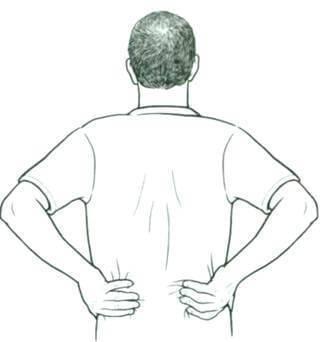
Fig. 9.6. Massage kidney
Some people's shoulders are not flexible enough, so they can not put your hands directly on the lower back. In this case, such a method is a good alternative available for almost everyone. Gently make a fist, holding the thumbs index fingers. Put the sides of the fists on the lower back so that the joints of the thumb and forefinger touched your back just above the kidneys.
You can do a circular movement, as described above, or just move the fists up and down. As before, try to make enough power to move the muscles under the skin, not the skin itself. With practice you will be able to feel the movement of your hands slip and kidneys.
7. For men only: prostate massage
The prostate is a gland the size of a walnut located between the bladder and the penis, ahead the rectum. The urethra runs through the center of the prostate, from the bladder to the penis, allowing urine to exit the body.
Along with the attached seminal vesicles, the prostate produces a slightly alkaline fluid that nourishes and protects sperm. During ejaculation this fluid is secreted into the urethra and comes out with sperm as semen. The alkaline environment of seminal fluid helps neutralize the acidic environment of the vagina, which increases the lifespan of the sperm cells.
Although some men this exercise can embarrass you or make you feel uncomfortable, prostate massage is very important for General and sexual health of men. Regardless of sexual activity, the prostate with age, usually increasing, it accumulates in the blood, prostatic and other body fluids.
This creates preconditions for the emergence of benign prostatic hyperplasia (BPH), benign tumors of the prostate, which can cause discomfort, burning during urination, frequent urination and inability to hold urine when the urge, frequent night urination and, among other things, increase the likelihood of urinary tract infection.
Although, according to Western medicine, between BPH and prostate cancer there is no obvious relationship from the point of view of Chinese medicine, the factors that cause BPH, and secondary obstruction of the enlarged prostate gland may become precursors of cancer. Prostate massage can prevent or reverse some of the contributing factors and in any case will improve prostate health.
The principle of prostate massage is familiar to most men, because it is almost identical pallavolo rectal study, which the doctors examine the prostate during a standard inspection.
The main difference is the position of the body, as the massage you will be doing yourself and your posture should be chosen accordingly, and the number used in the practice of power. Many doctors during a digital rectal examination move your finger too hard that can be extremely frustrating and even painful. Although most men have never experienced the pleasure of prostate massage, it does not have to be physically unpleasant experience.
How to perform
Before you start, buy latex gloves, which can be found in any pharmacy, and grease. You can use a water soluble lubricant such as K-Y Jelly, or any natural vegetable oil, such as olive. If you have weak or bad knees or you are not flexible enough — do this massage while sitting on the toilet. If you have good flexibility you can squat in this position you can easily enter your finger and find the prostate.
Put on a glove in any convenient hand. Squeeze a bit of lubricant on the middle finger. The middle finger is longer than the others, and you'll be able to feel the prostate. With practice you will be able to use your index finger if you want. Then sit on his haunches or toilet seat. Push a hand between her legs, scrotum, and enter a greased finger into the rectum as deeply as possible (Fig. 9.7). The tip of your index finger will be deployed to the front of the body. Push forward and slightly upward to the base of the penis.
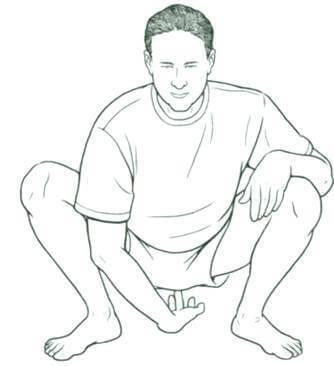
Fig. 9.7. For men only: prostate massage
Feel a bulge the size of a walnut or a lump in the muscle wall. It's your prostate. If you ever researched the prostate, it is familiar. A healthy prostate is thick and elastic, but not hard as a tense bicep. You can easily put pressure on her.
Apply steady even pressure without poking and jerks, to the entire surface of the prostate that can be felt. When pressing on the prostate of the penis can stand a little prostatic fluid. As with massage of any part of the body, it will improve the inflow of healthy blood and nutrients to the tissue of the prostate and the surrounding muscles will help to remove toxic congestion of the prostate and highlight the prostatic fluid.
Healthy men under 40 years of one or two massages per month will be enough. Those who are older, it is recommended to do it 1 time a week, and for those who have painful, frequent or difficult urination (in the absence of a diagnosed condition requiring treatment), 2 times a week or more, with any frequency, which will help to remove signs of discomfort. As soon as they disappear, the massage can be done less frequently.
8. For women only: breast massage
This version of massage is designed specifically to strengthen General and women's sexual health.
Hormonal system of women is more complex than men, the number of connections and interactions of hormones is much higher. Mammary glands and ducts located in the breast, are responsible for the production and delivery of milk during lactation.
The chest also responds to the sex hormones estrogen and progesterone, which are produced by the ovaries; among other things, they affect the change in size and increase in sensitivity of the breast during the menstrual cycle.
Oxytocin, a hormone usually produced by the hypothalamus in response to stimulation of the nipples (as part of the chest), is primarily responsible for sexual arousal, childbearing and stimulation of the birth, beginning and maintaining lactation, and also for the feeling of emotional and psychological well-being and freedom from stress. It also indirectly linked with the learning ability and memory.
From the Chinese point of view, all the hormones relate to the type of the essences of Jing, a substance that nourishes and rejuvenates the body. In this sense, the especially effective hormones. In addition, through the Breasts undergo several acupuncture meridians, providing a particular energy interconnections.
Many of these meridians begin at the feet and end at the head, indicating the interconnectedness of the breast with the entire body and its influence on the mental and emotional state. The Kidney Meridian runs through the genitalia and is largely associated with sexual health and functions. In the breast it is located in the center, close to the sternum.
The Liver Meridian encircles the genitals and runs almost in the center of the chest, however the last point acupuncture on it is just under the breast. Most many menstrual and other gynecological disorders are treated through the Liver.
External used for the acupuncture portion of the Meridian of the Pericardium or Heart bag, starts right at the outer edge of the nipple. The connection of the pericardium with the heart explains its relationship with love and other human emotions. The Spleen Meridian runs from the nipple, behind the Pericardium Meridian and the Stomach Meridian runs right through the nipple and the middle line of the chest.
Spleen and stomach are paired organs, Yin and Yang, their functions are interrelated. The spleen, for example, involved in the production of blood, therefore its relationship with menstruation is obvious, and it is easily exposed to the liver, which is especially noticeable when emotional distress leads to loss of appetite and indigestion.
How to perform
This exercise can be performed in an easy shirt. You can also wear a light sports bra with no underwire, but the bra will embarrass you, and lower sensitivity, so it is undesirable. If you can, sit on the floor, placing any of the heels from the entrance to the vagina, lightly touching her clitoris, and the second leg extend or bend in front of him.
If you can't accept that position, sit in a chair, by placing a tennis ball, rolled sock or some other elastic, but not too hard object at the entrance to the vagina. Light touch stimulates the acupuncture points in this place and may additionally increase the production of hormones, increasing the beneficial effects of this exercise. RUB your palms together until they are nice and warm, indicating a rush of blood and Qi to your palms. Put your hands on both Breasts and feel the warmth of your hands penetrate into the breast tissue.
For most women, and most medical tasks are best suited to the circular motion of the hands upwards along the sternum (Fig. 9.8 A), to the sides, across the tops of the Breasts, down the outside of the Breasts (Fig. 9.8 B), and in the center towards the sternum just below the Breasts. Make 36 laps. It stimulates the passage of Qi through all the meridians and is a scattering technique, which removes all stagnant in the chest Qi.
It is very important to dissipate stagnant Qi in the chest, as virtually all physiological changes precede change in energy. Some physiological changes are relatively harmless, such as a gain and breast tenderness before menstruation.
The scattering technique can relieve this pain. Although this technique is most effective when the daily perform, but should take at least a few days before the expected monthly increase sensitivity. In this case, it is recommended to do 100 circular motion 2 times a day. For lactating women, the dispersion is contraindicated, even if they have breast tenderness. This technique is not recommended for lactating mothers because it can reduce lactation. You can return when the woman stops breastfeeding.

Fig. 9.8 A. for women Only: breast massage
In other cases, the Qi stagnation in the chest can lead to fibrotic nodes, cysts and even cancer. Qi mainly accumulates in the breast due to prolonged strong emotions or physical injury.
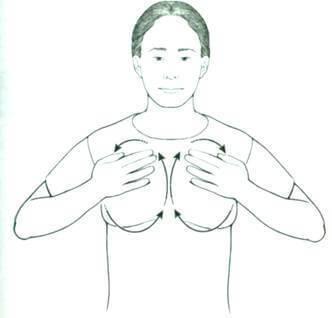
Fig. 9.8 B. for women Only: breast massage
Known cases when athletes had trouble even Jogging, because their hands constantly rubbed or bumped to the side of the chest, or due to poor support of the breast Bouncing that was the cause of the microtrauma of the tissues.
The second method of exercise for glands 8
Young women with small Breasts who seek to increase it, and nursing who have problems with lactation, instead of scattering it is necessary to perform the picking up. The gathering is done the same way as dispersion, only the circular movements should be directed in the opposite direction. This will bring in more chest Qi.
In women with very small Breasts may be an imbalance or deficiency of certain hormones. (However, such a conclusion is not enough to consider only the size of the breast. To identify other factors necessary to consult a doctor.) In this case, the additional inflow Qi to the breast will not harm the young women, as this practice will help to cure the imbalance.
Since in this situation the practice is not for General good health, and for a purpose, it is also recommended to do 100 circular motion 2 times a day. If after 6 or at most 9 months, the chest has not increased, so, in your case this practice will not help, and you need to start to do the scattering for General good health.
Since the aim of this practice — local increase in tissue not related to the muscles, that 9 months was a reasonable waiting period for the result. Once the breast reaches the desired size, the practice of gathering should be reduced to 36 of the circular movements of 1 times a day and several times a week to replace it with "dispersion" to prevent Qi stagnation.
For the treatment of insufficient lactation is also recommended to do 100 circular motion 2 times a day. Once a woman stops breastfeeding, you need to renew the dispersion for General good health. published
P. S. And remember, only by changing their consumption — together we change the world! ©
Source: www.medmoon.ru/dieta/uprazhn_dlja_zhelez_1.html
The secretion of glands affects every aspect of human physiology in all stages of life, from birth to death. If we also take into account that the secretions of our glands are the substance of Yin, we can say that they affect us from the moment of conception, and even earlier.
Scope of impact includes the growth, development, the process of cell renewal and regeneration (in other words, how quickly and how well we age), sexuality and reproduction, immune support, metabolism, energobrazovania, utilization of nutrients, emotional balance, mental perception, everything is regulated with hormones, and much that at first glance does not depend on hormones. Therefore, maintaining the health of the glands is very important.

1. The tapping of the epiphysis
The pineal gland is a gland approximately the size of a pea. It is located near the center of the brain between the two hemispheres. It converts nerve signals from the sympathetic nervous system, hormonal, establishing a link between the endocrine and nervous systems. In addition, it produces melatonin, which regulates rhythms of sleep/wakefulness and affects sexual development.
How to perform the exercise
Index and/or middle finger separately, simultaneously or alternately, start rattling the area between the eyebrows at the point, better known as the "third eye".
Although the pineal gland is located in the center of the brain, there is an energy path that connects it with the "external third eye". At this point you can see the notch in the bone, but it may not be. The tapping should be soft and measured, it should cause a pleasant sensation, like a slight tickle.
Prostukivanie 1 or 2 minutes. The number of repeats is not limited. Remember that you need to achieve incremental improvement over time. To achieve this once by long tapping will not work — moreover, it will give the opposite result. You follow energy practices or not, this is an area where easily formed Qi stagnation. Basically, this is manifested headache localized in this region. Mental strain, anxiety, eye strain, and energy practices aimed at lifting energy up the body, but not to the end of providing a reverse circulation (which may be the result of an error or inexperience practitioners), are just a few of the reasons Qi can be stuck there.

2.Tapping on the pituitary and hypothalamus
The pituitary is located at the base of the brain between the optic nerves, in front of the spinal cord. This small endocrine organ is often called the main gland because it controls other endocrine glands by increasing or decreasing the level of hormones that they produce.
One of the most famous hormones, human growth hormone (HGH) affects cell growth and renewal, regulates other glands and, as many believe, is our internal "fountain of youth". High level of HGH in the blood can slow down and even reverse many signs of aging. In addition, the pituitary gland affects the muscles and kidneys, and even accumulate some of the hormones produced by the hypothalamus.
Located deep in the brain near the center of the cranial cavity, the hypothalamus lies under the thalamus (switching center for sensory and motor pathways in the brain). The latter has a structural and functional connection with the hypothalamus, which is located underneath and is attached with thin bundles of nerve fibers and blood vessels.
This is a control center for many autonomic functions of the peripheral nervous system. Thanks to the relations between the structures of the endocrine and nervous systems hypothalamus plays an important role in maintaining homeostasis, regulating body temperature, blood pressure and heart rate.
It affects the function of the ovaries and testes, mood and behavior, sleep cycles, energy level and overall metabolism. It is sometimes called the "brain" of the brain: almost all the functions of the hypothalamus are to control the brain and its connection with the body, because he is their liaison. Because the pituitary and hypothalamus are anatomically close and their work is interrelated, this exercise is drawn simultaneously to the pituitary gland, and hypothalamus.
How to perform
The easiest way to perform this tapping — approach "shotgun", that is, the promise of relatively strong waves in your head. There are more accurate, specialized methods, but this exercise is very effective and it can perform each.
Gently clench a loose fist and start rattling the back of the head at the base of the skull, beneath the bone and near the side surface of the cervical vertebrae. You can use or extreme knuckle four fingers (Fig. 9.1) or, for a more directional influence, the base of each knuckle side of the little finger (Fig. 9.2).
You can keep your head straight or tilt slightly forward, so if you would prefer to reach the base of the skull. Quickly alternate hands while tapping and direct impact force of the right hand to the left eye and force the left hand to the right eye. Thus, the wave will pass through the pituitary gland and the hypothalamus.
In addition, you can feel like a wave diffuse spreads all over or almost all over the head. This is normal and provides some secondary benefits. As an additional benefit it will soften and relax tense neck muscles that most people are at the base of the skull and on the back of the neck.
Prostukivanie 1-2 minutes. The number of repeats is not limited. Remember that you need to achieve incremental improvement over time. To achieve this once by long tapping will not work, moreover, it will give the opposite result.

Fig. 9.1. Tapping on the pituitary and hypothalamus

Fig. 9.2. Tapping on the pituitary and hypothalamus
3. Massage of the thyroid gland
The thyroid gland is shaped like a butterfly and located at the base of the front of the neck, under the Adam's Apple along the windpipe. It produces several thyroid hormones. Thyroid hormones affect the whole body, influencing metabolism, growth and development, body temperature. They are necessary for brain development in infancy and childhood, and in adults, they contribute to the functioning of the nervous, cardiovascular and digestive systems.
In addition, this massage is very beneficial for the parathyroid glands, four organs the size of a pea, which are located behind the thyroid gland. They increase the level of calcium in the blood, helping to maintain the integrity of bones and an adequate supply of calcium, which is necessary for the muscle and transfer of intercellular signals.
From the energy point of view, along the front of the neck is the many acupuncture points, through which the meridians of the Stomach and colon. The stomach and its paired Yin organ, the Spleen, affect muscle function of the digestive system; paired organs of the colon are Easy.
Lungs and spleen are involved in metabolism, which affects the production of energy. This coincides with similar functions of the thyroid gland. The base of the throat is also the location of the fifth chakra, which is associated with communication, expression and creativity in the field of communication and expression in it. Honest communication and self-expression in our culture it is often discouraged and surprised, both at work and at home, so the throat is another area where it is often Qi stagnation.
Since the front surface of the neck is more sensitive and not well protected by thick muscles or bones, this exercise is massage, which is performed in three stages. For this exercise, determine the right hands — left hands are not required, you can change hands as you see fit.
How to perform
Place the thumb and forefinger of the left hand at the base of the throat, directly on the clavicles, on bone outgrowths that feel to it. Holding the base of the neck and collarbone, gently push on the latter. Right hand position directly over the left, right thumb over the index finger of the left hand and the index finger of the left hand over the left thumb.
Gently but firmly grasp the sides of the throat and gently slide your right hand up, stretching the throat, while the fingers will not touch the outer edge of the lower jaw (Fig. 9.3). At this point you will feel the sides of the base of the tongue. Gently push up for a few seconds. Repeat this stretch and lift the throat 2 times.
After the third repetition, hold the right hand under the lower jaw, move your left hand to move to the next part of this exercise. So it was easier to hold his throat, add middle and ring fingers. Starting directly under the jaw, slip the throat from side to side to feel how several times you move it back and forth.
There should be no pain, you should not have the feeling that you're choking. Then slightly push the arm down and repeat. Depending on the size of your hands and neck length, you can divide the throat into three, four or five plots, at a time when you move from side to side is one of them. You can feel or hear the crunch when you released the bone. You can feel in the throat a slight tickle that causes the cough.
Both of these reactions are normal. One approach is usually sufficient, but if you want to repeat 2 or 3 times, that's okay too.

Fig. 9.3. Massage of the thyroid gland
The last part of this exercise — direct acupressure. Most of these points are not standard acupuncture, as the needles are directed into the areas of the meridians, which are located in the muscles, not the throat. Here you will use your thumb and index finger as tweezers, directing the force to the sides of the throat and to the extent possible, ago.
During the previous two exercises, you could feel the small grooves on the sides of the throat. You need to press so hard that the fabric physically shifted under your fingers. When you succeed, start making small circular movements with your fingers 10 times in one direction and 10 in the opposite direction. Then slide your fingers down to the next section between the grooves, and repeat. Continue down the neck until you reach the base of the throat.
Note: as in men, in women touching the thyroid cartilage, where men is an outstanding Adam's Apple, feeling during palpation will be very similar to the probing of the bone. In fact, over the thyroid cartilage is a bone called the hyoid, it is fragile, so be careful at any bone site.
Sometimes a weak tilt of the head reveals your neck so that you can feel the depressions between the grooves and there, but you may need to completely skip this area. Not right to put pressure on the bone structure that you can find.
4. The tapping of the thymus
The thymus is a gland composed of lymphatic tissue, which is located in the upper part of the chest, behind the sternum (breast bone), midway between the apex of the heart and the jugular notch of the sternum at the base of the throat. It is most active in childhood and grows up to puberty, after which it begins to atrophy.
In recent years, it became known that the thymus plays an important role in adulthood. It is part of the immune system by converting lymphocytes, white blood cells produced by the bone marrow, T cells developing in the thymus.
These cells migrate to various lymph nodes, where they play an important role in combating infection and diseases. In addition, the thymus produces hormones that regulate the maturation of T-cells. The tapping stimulates the thymus gland, helping to maintain its functional activity in adulthood.
How to perform
Gently squeeze one fist any hand and start to rattle the top edge of the chest over the sternum, below the recess under the throat and above the heart. Change the rhythm, speed and force of the blows, to feelings of discomfort. The body is able to adapt to any repetitive stimulus and, ultimately, to ignore it. Change the speed, rhythm and force of the blows make this impossible. Do this exercise for 1 -2 minutes each day.
5. The tapping of the kidneys/adrenal
The adrenal gland is a paired gland, triangular in shape measuring 2.5-5 cm, behind both kidneys. They produce over 36 of the hormones which are delivered directly into the blood. The function of the outer shell is regulated by the pituitary hormone, called adrenocorticotropic hormone, and it produces steroid hormones such as cortisone and testosterone, which play an important role in the storage and use of energy affect sexual function and many aspects of the chemical composition of blood.
The smaller, inner shell is part of the sympathetic nervous system and responds to physical and emotional stress. Reacting to fear, anger or emergency, it produces epinephrine and norepinephrine (adrenaline and noradrenaline), which is sometimes called the hormone of "fight or flight".
Kidney is bean — shaped organs the size of a fist, located in the lumbar region on both sides of the spine. They filter the blood from toxic substances and excrete them in the urine. In addition, they derive from normal blood substances that are in it in high concentrations (so-called maintenance of homeostasis). The buds themselves are endocrine glands that produce the hormones erythropoietin, which is involved in the formation of red blood cells, and cortisol — the active form of vitamin D.
The main causes of kidney damage are diabetes and hypertension — two diseases most common in our days. This exercise can't fix damage already done but can prevent their occurrence and to support the overall health of the kidneys and adrenal glands.
How to perform
This exercise can be done standing but it is sitting on the floor, in a chair or on a chair much easier. Squeeze both hands into weak fists and either part with the thumb and index finger (Fig. 9.4), or the basis of the kulaks (Fig. 9.5) prostuchite lower back from the lower ribs to the upper part of the pelvis.

Fig. 9.4. The tapping of the kidneys/adrenal
Many people suffer from tension in the lower back, discomfort, or pain, and this tapping helps to remove them. A hundred lashes for each kidney will take about a minute, and it at least daily for this exercise. If you want to rattle for a few minutes longer. The kidneys are sensitive organs, and therefore, changing the rhythm and speed of tapping, make sure that the blows were not too strong.

Fig. 9.5. The tapping of the kidneys/adrenal
6. Massage kidney
"The tapping of the kidneys/adrenal glands", as described above, disperse stagnant Qi, and, for many reasons, it needs to be done to "Massage of the kidney". Massage kidney has a soothing, nourishing and warming effect, it calms the Qi and healthy Qi gathers, to tone and heal the kidneys.
In Chinese medicine it is believed that the kidneys affect the health and life in the truest sense of more complex interactions than accounted for in Western medicine.
This, for example, growth and development in childhood, sexual/reproductive health and vitality (the testicles are often called "external kidneys"), dental health (as a continuation of the healthy bone), hair, longevity/healthy aging, hearing acuity, memory and concentration.
Along with this, according to Western medicine, the kidneys participate in the metabolism of fluids and excretion of wastes. Keeping the kidneys healthy is one of the main keys to a long and healthy life.
How to perform
Massage of the kidneys can be done in one of two ways. If possible, in the kidney it is best to work directly with his hands. By this method, in 1-2 minutes, RUB hands to warm them, guiding them more blood and Qi. Then put his hands on waist right hand on the right kidney and left hand on left kidney (Fig. 9.6).
1-2 minutes to massage in small circular motions, first in one direction and the same in another. Try to maximize the use of local muscle that you do not just stroking the skin, but also shifted the muscles. Feel the warmth of your hands is poured into the kidneys. Time for this exercise is not limited, therefore, if you wish, you can run it up to several minutes.

Fig. 9.6. Massage kidney
Some people's shoulders are not flexible enough, so they can not put your hands directly on the lower back. In this case, such a method is a good alternative available for almost everyone. Gently make a fist, holding the thumbs index fingers. Put the sides of the fists on the lower back so that the joints of the thumb and forefinger touched your back just above the kidneys.
You can do a circular movement, as described above, or just move the fists up and down. As before, try to make enough power to move the muscles under the skin, not the skin itself. With practice you will be able to feel the movement of your hands slip and kidneys.
7. For men only: prostate massage
The prostate is a gland the size of a walnut located between the bladder and the penis, ahead the rectum. The urethra runs through the center of the prostate, from the bladder to the penis, allowing urine to exit the body.
Along with the attached seminal vesicles, the prostate produces a slightly alkaline fluid that nourishes and protects sperm. During ejaculation this fluid is secreted into the urethra and comes out with sperm as semen. The alkaline environment of seminal fluid helps neutralize the acidic environment of the vagina, which increases the lifespan of the sperm cells.
Although some men this exercise can embarrass you or make you feel uncomfortable, prostate massage is very important for General and sexual health of men. Regardless of sexual activity, the prostate with age, usually increasing, it accumulates in the blood, prostatic and other body fluids.
This creates preconditions for the emergence of benign prostatic hyperplasia (BPH), benign tumors of the prostate, which can cause discomfort, burning during urination, frequent urination and inability to hold urine when the urge, frequent night urination and, among other things, increase the likelihood of urinary tract infection.
Although, according to Western medicine, between BPH and prostate cancer there is no obvious relationship from the point of view of Chinese medicine, the factors that cause BPH, and secondary obstruction of the enlarged prostate gland may become precursors of cancer. Prostate massage can prevent or reverse some of the contributing factors and in any case will improve prostate health.
The principle of prostate massage is familiar to most men, because it is almost identical pallavolo rectal study, which the doctors examine the prostate during a standard inspection.
The main difference is the position of the body, as the massage you will be doing yourself and your posture should be chosen accordingly, and the number used in the practice of power. Many doctors during a digital rectal examination move your finger too hard that can be extremely frustrating and even painful. Although most men have never experienced the pleasure of prostate massage, it does not have to be physically unpleasant experience.
How to perform
Before you start, buy latex gloves, which can be found in any pharmacy, and grease. You can use a water soluble lubricant such as K-Y Jelly, or any natural vegetable oil, such as olive. If you have weak or bad knees or you are not flexible enough — do this massage while sitting on the toilet. If you have good flexibility you can squat in this position you can easily enter your finger and find the prostate.
Put on a glove in any convenient hand. Squeeze a bit of lubricant on the middle finger. The middle finger is longer than the others, and you'll be able to feel the prostate. With practice you will be able to use your index finger if you want. Then sit on his haunches or toilet seat. Push a hand between her legs, scrotum, and enter a greased finger into the rectum as deeply as possible (Fig. 9.7). The tip of your index finger will be deployed to the front of the body. Push forward and slightly upward to the base of the penis.

Fig. 9.7. For men only: prostate massage
Feel a bulge the size of a walnut or a lump in the muscle wall. It's your prostate. If you ever researched the prostate, it is familiar. A healthy prostate is thick and elastic, but not hard as a tense bicep. You can easily put pressure on her.
Apply steady even pressure without poking and jerks, to the entire surface of the prostate that can be felt. When pressing on the prostate of the penis can stand a little prostatic fluid. As with massage of any part of the body, it will improve the inflow of healthy blood and nutrients to the tissue of the prostate and the surrounding muscles will help to remove toxic congestion of the prostate and highlight the prostatic fluid.
Healthy men under 40 years of one or two massages per month will be enough. Those who are older, it is recommended to do it 1 time a week, and for those who have painful, frequent or difficult urination (in the absence of a diagnosed condition requiring treatment), 2 times a week or more, with any frequency, which will help to remove signs of discomfort. As soon as they disappear, the massage can be done less frequently.
8. For women only: breast massage
This version of massage is designed specifically to strengthen General and women's sexual health.
Hormonal system of women is more complex than men, the number of connections and interactions of hormones is much higher. Mammary glands and ducts located in the breast, are responsible for the production and delivery of milk during lactation.
The chest also responds to the sex hormones estrogen and progesterone, which are produced by the ovaries; among other things, they affect the change in size and increase in sensitivity of the breast during the menstrual cycle.
Oxytocin, a hormone usually produced by the hypothalamus in response to stimulation of the nipples (as part of the chest), is primarily responsible for sexual arousal, childbearing and stimulation of the birth, beginning and maintaining lactation, and also for the feeling of emotional and psychological well-being and freedom from stress. It also indirectly linked with the learning ability and memory.
From the Chinese point of view, all the hormones relate to the type of the essences of Jing, a substance that nourishes and rejuvenates the body. In this sense, the especially effective hormones. In addition, through the Breasts undergo several acupuncture meridians, providing a particular energy interconnections.
Many of these meridians begin at the feet and end at the head, indicating the interconnectedness of the breast with the entire body and its influence on the mental and emotional state. The Kidney Meridian runs through the genitalia and is largely associated with sexual health and functions. In the breast it is located in the center, close to the sternum.
The Liver Meridian encircles the genitals and runs almost in the center of the chest, however the last point acupuncture on it is just under the breast. Most many menstrual and other gynecological disorders are treated through the Liver.
External used for the acupuncture portion of the Meridian of the Pericardium or Heart bag, starts right at the outer edge of the nipple. The connection of the pericardium with the heart explains its relationship with love and other human emotions. The Spleen Meridian runs from the nipple, behind the Pericardium Meridian and the Stomach Meridian runs right through the nipple and the middle line of the chest.
Spleen and stomach are paired organs, Yin and Yang, their functions are interrelated. The spleen, for example, involved in the production of blood, therefore its relationship with menstruation is obvious, and it is easily exposed to the liver, which is especially noticeable when emotional distress leads to loss of appetite and indigestion.
How to perform
This exercise can be performed in an easy shirt. You can also wear a light sports bra with no underwire, but the bra will embarrass you, and lower sensitivity, so it is undesirable. If you can, sit on the floor, placing any of the heels from the entrance to the vagina, lightly touching her clitoris, and the second leg extend or bend in front of him.
If you can't accept that position, sit in a chair, by placing a tennis ball, rolled sock or some other elastic, but not too hard object at the entrance to the vagina. Light touch stimulates the acupuncture points in this place and may additionally increase the production of hormones, increasing the beneficial effects of this exercise. RUB your palms together until they are nice and warm, indicating a rush of blood and Qi to your palms. Put your hands on both Breasts and feel the warmth of your hands penetrate into the breast tissue.
For most women, and most medical tasks are best suited to the circular motion of the hands upwards along the sternum (Fig. 9.8 A), to the sides, across the tops of the Breasts, down the outside of the Breasts (Fig. 9.8 B), and in the center towards the sternum just below the Breasts. Make 36 laps. It stimulates the passage of Qi through all the meridians and is a scattering technique, which removes all stagnant in the chest Qi.
It is very important to dissipate stagnant Qi in the chest, as virtually all physiological changes precede change in energy. Some physiological changes are relatively harmless, such as a gain and breast tenderness before menstruation.
The scattering technique can relieve this pain. Although this technique is most effective when the daily perform, but should take at least a few days before the expected monthly increase sensitivity. In this case, it is recommended to do 100 circular motion 2 times a day. For lactating women, the dispersion is contraindicated, even if they have breast tenderness. This technique is not recommended for lactating mothers because it can reduce lactation. You can return when the woman stops breastfeeding.

Fig. 9.8 A. for women Only: breast massage
In other cases, the Qi stagnation in the chest can lead to fibrotic nodes, cysts and even cancer. Qi mainly accumulates in the breast due to prolonged strong emotions or physical injury.

Fig. 9.8 B. for women Only: breast massage
Known cases when athletes had trouble even Jogging, because their hands constantly rubbed or bumped to the side of the chest, or due to poor support of the breast Bouncing that was the cause of the microtrauma of the tissues.
The second method of exercise for glands 8
Young women with small Breasts who seek to increase it, and nursing who have problems with lactation, instead of scattering it is necessary to perform the picking up. The gathering is done the same way as dispersion, only the circular movements should be directed in the opposite direction. This will bring in more chest Qi.
In women with very small Breasts may be an imbalance or deficiency of certain hormones. (However, such a conclusion is not enough to consider only the size of the breast. To identify other factors necessary to consult a doctor.) In this case, the additional inflow Qi to the breast will not harm the young women, as this practice will help to cure the imbalance.
Since in this situation the practice is not for General good health, and for a purpose, it is also recommended to do 100 circular motion 2 times a day. If after 6 or at most 9 months, the chest has not increased, so, in your case this practice will not help, and you need to start to do the scattering for General good health.
Since the aim of this practice — local increase in tissue not related to the muscles, that 9 months was a reasonable waiting period for the result. Once the breast reaches the desired size, the practice of gathering should be reduced to 36 of the circular movements of 1 times a day and several times a week to replace it with "dispersion" to prevent Qi stagnation.
For the treatment of insufficient lactation is also recommended to do 100 circular motion 2 times a day. Once a woman stops breastfeeding, you need to renew the dispersion for General good health. published
P. S. And remember, only by changing their consumption — together we change the world! ©
Source: www.medmoon.ru/dieta/uprazhn_dlja_zhelez_1.html
